Rust Family Foundation: Archaeology Grants Program
The Peshdar Plain Chalcolithic Project
Principal Investigators:
Dr. Mark Altaweel, Institute of Archaeology, University College London
Dr. Andrea Squitieri, Ludwig-Maximilians-Universität München
Since 2015 the Peshdar Plain Project directed by K. Radner (LMU, Munich) and, since 2018, by F. J. Kreppner (Münster University) has been investigating the Dinka Settlement Complex (UTM 38S E 512280, N 3999500), an Iron Age settlement extending in the Bora Plain, a subunit of the much larger Peshdar Plain, located between the Zagros Mountains and th
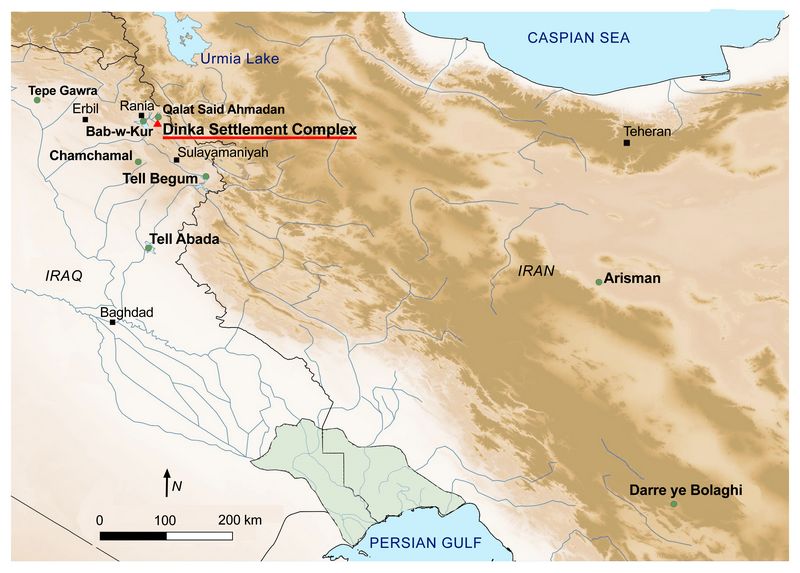 e Lake Dokan,
in the region of Sulaymaniyah (Kurdistan Autonomous Region of Iraq).
During the 2018 excavations, a Chalcolithic kiln was intercepted below
the Iron Age buildings unearthed in the operation called DLT3. This
discovery has prompted us to intensify the excavation of this kiln with
the ad hoc, small-scale project named “Peshdar Plain Chalcolithic
Project”, funded ss the current project (RFF-2019-95). The excavations
of the kiln were scheduled for the spring of 2019.
e Lake Dokan,
in the region of Sulaymaniyah (Kurdistan Autonomous Region of Iraq).
During the 2018 excavations, a Chalcolithic kiln was intercepted below
the Iron Age buildings unearthed in the operation called DLT3. This
discovery has prompted us to intensify the excavation of this kiln with
the ad hoc, small-scale project named “Peshdar Plain Chalcolithic
Project”, funded ss the current project (RFF-2019-95). The excavations
of the kiln were scheduled for the spring of 2019. Fig.1: The location of the Dinka Settlement Complex in the Peshdar Plain (Iraqi Kurdistan) and other Chalcolithic sites in the area.
The investigation of this kiln is particularly relevant for our understanding of the Chalcolithic period in the Peshdar Plain, as well as in Iraqi Kurdistan. The Chalcolithic period (c. 6000 – 3500 BC) was a period of intense innovation in human societ
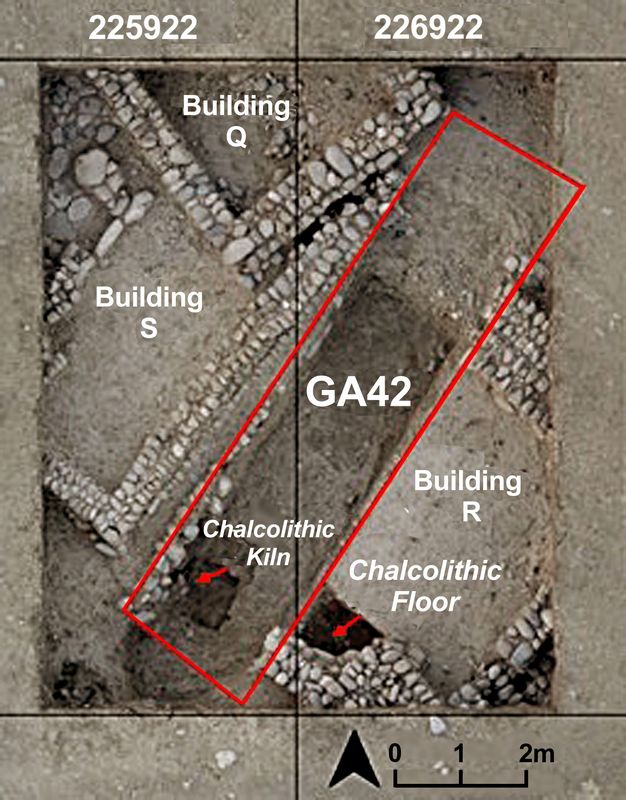 ies, which developed from
the small-scale agricultural villages typical of the Neolithic period
(c. 10000 – 6000 BCE) into the large city-states that characterized the
Bronze Age (c. 3500 – 1200 BCE) (Rothman 2002). Neither the timeline
nor and trajectory of this transformation, not the breadth of contact
between northern and southern Mesopotamia, or between northern
Mesopotamia and Iran, are well understood, particularly in areas like
Iraqi Kurdistan (Stein 2013; Stein and Alizadeh 2013).
ies, which developed from
the small-scale agricultural villages typical of the Neolithic period
(c. 10000 – 6000 BCE) into the large city-states that characterized the
Bronze Age (c. 3500 – 1200 BCE) (Rothman 2002). Neither the timeline
nor and trajectory of this transformation, not the breadth of contact
between northern and southern Mesopotamia, or between northern
Mesopotamia and Iran, are well understood, particularly in areas like
Iraqi Kurdistan (Stein 2013; Stein and Alizadeh 2013). Fig.2: The location of the Chalcolithic kiln beneath the Iron Age buildings (Buildings Q, S, R) of the Dinka Settlement Complex in the operation DLT3 of the Lower Town
Previous work at the site:
Research in Iraqi Kurdistan focusing on the Chalcolithic period has been carried out in the past decades, e.g. in the Erbil, Rania, and Sharizor plains, and in the Chamchamal area (Peyronel and Vacca 2015, Stein and Alizadeh 2013, Wengrow et al. 2016, Bruun Skuldbøl and Colantoni 2016, Vallet 2017) (Fig. 1). However, scant research has been carried out in the Peshdar Plain, where, up to now, the main reference site for the Chalcolithic has
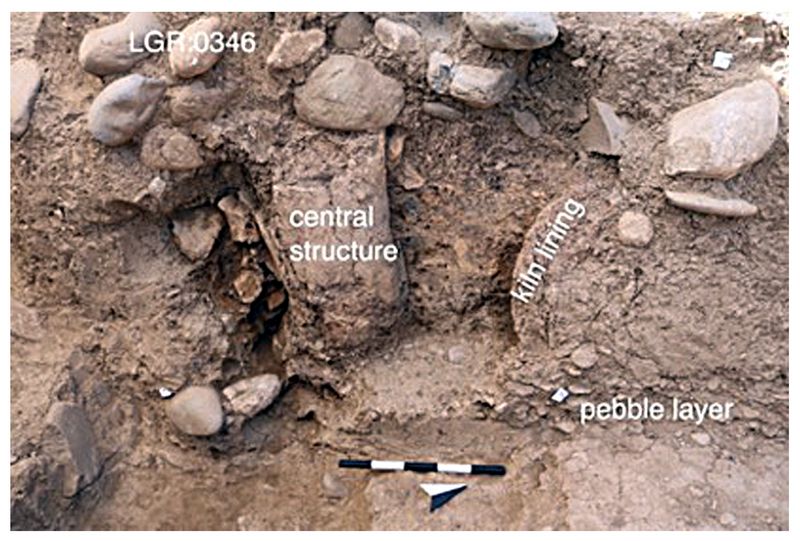 been at Qalat Said Ahmadan (UTM 38S 513191.51,
4008924.46). Results from this site are limited, and include only a
pottery sequence, but only a very few partially-excavated structures
pertaining to the Chalcolithic (Tsuneki et al. 2015). The Peshdar Plain
Chalcolithic Project was initiated to fill this gap in our knowledge.
been at Qalat Said Ahmadan (UTM 38S 513191.51,
4008924.46). Results from this site are limited, and include only a
pottery sequence, but only a very few partially-excavated structures
pertaining to the Chalcolithic (Tsuneki et al. 2015). The Peshdar Plain
Chalcolithic Project was initiated to fill this gap in our knowledge.Fig.3: The Chalcolithic kiln at the end of the 2018 autumn campaign when it was first discovered.
Current funded project (RFF-2019-95)B
Goals:
The goals of the projects were to:
1. Excavate the pottery kiln in its entirety to uncover its structure.
2. Analyse the pottery retrieved from a morphological and technological point of view through both macroscopic analysis and thin sections;
3. Collect samples suitable for radiocarbon dating;
4. Collect samples for micromorphological analysis from the kiln fill;
5. Collect samples for archaeomagnetic analysis from the kiln structure.
Goals 1 to 5 have all been successfully achieved (see below) although the results of the analysis referred to in points 4 and 5 will take several months to complete by specialists within Europe. Results from these analyses are expected by mid-2020.
Excavation results:
The excavations revealed that the kiln originally consisted of two parts. The upper part was the firing chamber, which was directly above ground level, while the other, the combustion chamber, was sunk into the ground. In between a perforated floor existed to support the pots. The upper chamber was fully destroyed by the
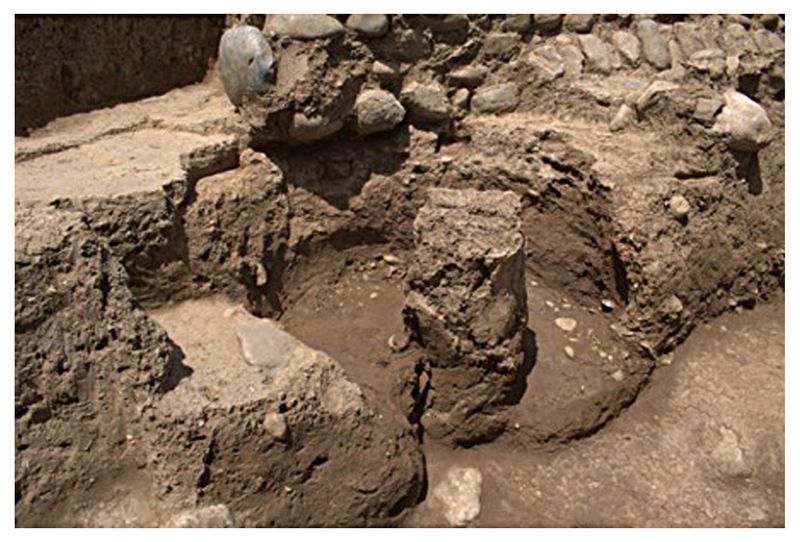 construction of the Iron Age
buildings (fig.4). Only a few tumbled remains of this chamber were
found inside the kiln’s fill. The lower chamber, dug into the ground,
was almost entirely preserved. It was dug into a natural layer of
pebbles. Inside this chamber, at the lowest level, there was a large
accumulation of friable, dark, yellowish-brown soil with some pebbles.
construction of the Iron Age
buildings (fig.4). Only a few tumbled remains of this chamber were
found inside the kiln’s fill. The lower chamber, dug into the ground,
was almost entirely preserved. It was dug into a natural layer of
pebbles. Inside this chamber, at the lowest level, there was a large
accumulation of friable, dark, yellowish-brown soil with some pebbles.Fig.4: The Chalcolithic kiln towards the end of the excavation. Note the central column in the middle of the lower chamber and the pebble surface at the bottom. The upper part was destroyed by the later Iron Age stone wall.
The lining of the combustion chamber consists of heavily-fired clay, with a greyish-greenish appearance. Towards the middle of the lower chamber is a central column, made of clayey material with a lining that
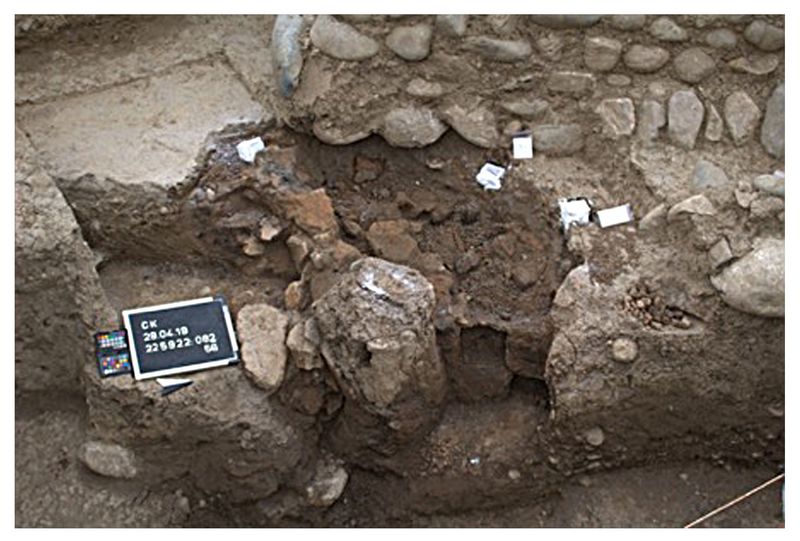 is more
light greyish than the outer lining. The northwestern part of the kiln
fill contained architectural elements representing the collapse of the
upper chamber, mixed with a dark brown soil and with some bones,
sherds, and flint (fig.5).
is more
light greyish than the outer lining. The northwestern part of the kiln
fill contained architectural elements representing the collapse of the
upper chamber, mixed with a dark brown soil and with some bones,
sherds, and flint (fig.5). Fig.5: The kiln in the process of excavation. Note the collapse of several reddish architectural elements from the upper part of the kiln found in the fill.
Among the architectural fragments are elongated plano-convex elements, which were part of a structure that extended radially from the edge of the kiln to the central column. This structure represented the kiln floor. They were observed in different sizes and at least one of these was slightly curved. There were also fragments of architectural elements with one flat side with a concave imprint on the reverse, which probably functioned to fix the planoconvex elements between the column and the
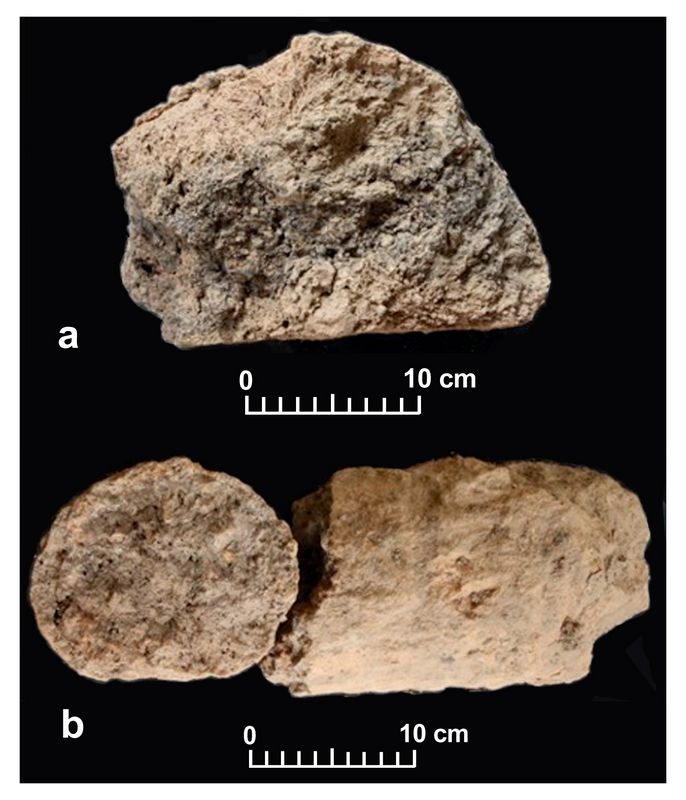 outer edge. A few
fragments with holes were found, which may have been part of the
original kiln floor. They may have been located at the edges of the
floor so to provide perforations that enabled the heat to go from the
lower into the upper (or firing) chamber. Several other architectural
pieces had a rather thick, flattish shape, and they most likely
belonged to the exterior casing of the firing chamber (figs.6-7).
outer edge. A few
fragments with holes were found, which may have been part of the
original kiln floor. They may have been located at the edges of the
floor so to provide perforations that enabled the heat to go from the
lower into the upper (or firing) chamber. Several other architectural
pieces had a rather thick, flattish shape, and they most likely
belonged to the exterior casing of the firing chamber (figs.6-7). Fig.6: Two types of architectural elements found in the kiln fill. a) Top: a plano-convex element; b) bottom: an elongated element with a plano-convex section.
Comparisons for this kiln can be observed in Chalcolithic sites in both northern Mesopotamia and Iran. Two-chamber kilns can be found in Tell Abada, in the Hamrin basin in Iraq, dated to 5th millennium BC (Jasim 19
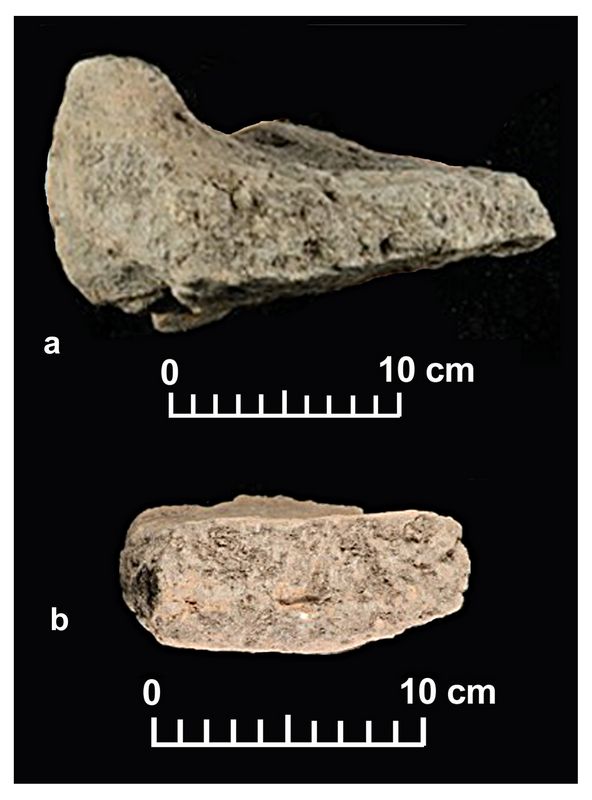 85, figs.
35a and 39). Close parallels to our kiln can also be found at the site
of Darre ye-Bolaghi, in southwestern Iran, in the province of Fars
(Helwing and Seyedin 2016: 285). Here several kilns were found. The
kiln 110 is very close to ours as it features a kiln floor formed with
a platform with holes on the edges, connected to a central column.
Another close parallel to our kiln can be found in the site of Arisman,
located in central Iran, in the province of Isfahan. There, the late
4th millennium BC levels yielded a pottery kiln showing a central
column connected to the kiln walls by a radial structure that supported
the kiln floor (Helwing and Seyedin 2016: 286; Boroffka-Becker 2004,
221).
85, figs.
35a and 39). Close parallels to our kiln can also be found at the site
of Darre ye-Bolaghi, in southwestern Iran, in the province of Fars
(Helwing and Seyedin 2016: 285). Here several kilns were found. The
kiln 110 is very close to ours as it features a kiln floor formed with
a platform with holes on the edges, connected to a central column.
Another close parallel to our kiln can be found in the site of Arisman,
located in central Iran, in the province of Isfahan. There, the late
4th millennium BC levels yielded a pottery kiln showing a central
column connected to the kiln walls by a radial structure that supported
the kiln floor (Helwing and Seyedin 2016: 286; Boroffka-Becker 2004,
221). Fig.7: a) Top: Fragment of the kiln floor; b) bottom: slightly curved fragment possibly belonging to the upper chamber of the kiln.
In summary, our kiln shows closer connections to Iran in terms of architecture. Such a link to the Iranian plateau does not come as a surprise considering the Bora Plain’s close proximity to Iran. Also, in the Iron Age, several other connections can be seen between the material culture of the Dinka Settlement Complex and that of Iranian sites. For the Chalcolithic period, therefore, the study of the material of this period coming from the Bora Plain can potentially clarify the relationship between Mesopotamia and Iran during the spread of the Chalcolithic traditions in both pottery and kiln architecture.
Pottery and radiocarbon dating:
The excavation of the kiln yielded 24 diagnostic sherds and 83 non-diagnostic sherds. A common shape is the flaring rim pot with faint red painting, made with a chaff-tempered fabric. Parallels of these pots can be found at other Mesopotamian sites, such as Tepe Gawra (Level XII A),
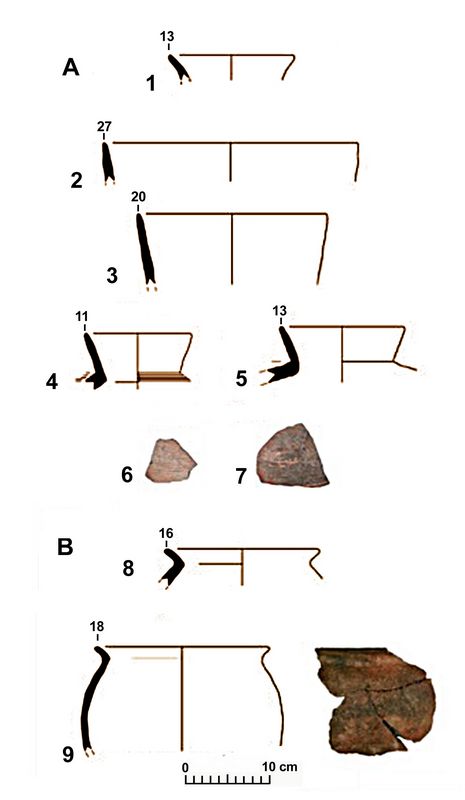 Nineveh (deep sounding), and Tell Ibrahim Bayis. In the
Peshdar Plain, similar pots come from the site of Qalat Said Ahmadan
(layer 1). Alongside this type of pot, we found round and thinned
everted rim fragments, made with an orange-coloured, chaff-tempered
clay; these rims most likely belong to deep bowls. Parallels occur at
Tepe Gawra (Level XII).
Nineveh (deep sounding), and Tell Ibrahim Bayis. In the
Peshdar Plain, similar pots come from the site of Qalat Said Ahmadan
(layer 1). Alongside this type of pot, we found round and thinned
everted rim fragments, made with an orange-coloured, chaff-tempered
clay; these rims most likely belong to deep bowls. Parallels occur at
Tepe Gawra (Level XII).This pottery was made using a coil method and, based on the horizontal orientation of the organic material on the surface and fluid striations, probably smoothed by hand. One piece of this type still bears the faint remains of a thin layer of red painting both outside and inside. One complete profile of a conical bowl with a thin rim and flat base was found in the kiln fill. It shows marks of pinching and drawing on the base (figs.8-9).
Fig.8: Main pottery types of the Chalcolithic period retrieved during both the autumn campaign in 2018 and the spring campaign in 2019. A(1-7): morphological types made with undetermined organically tempered fabric; B(8-9): types made with undetermined mineral-tempered fabric.
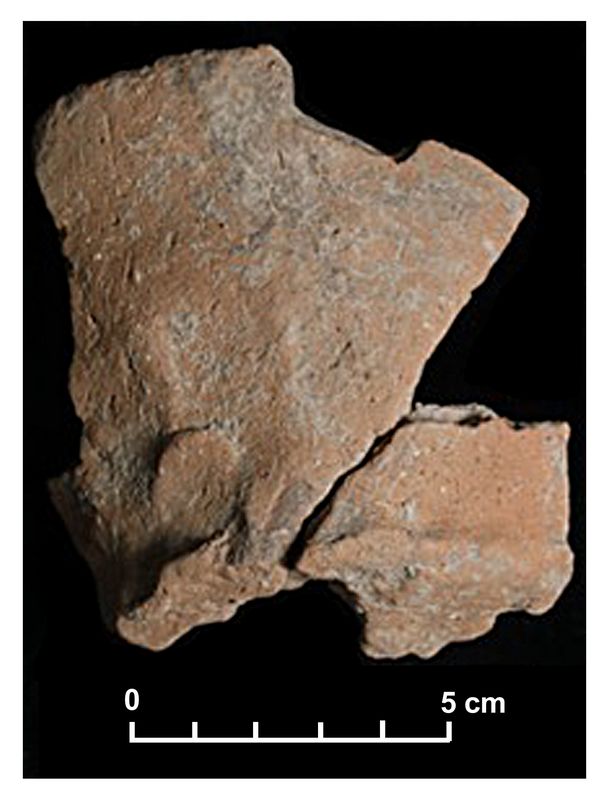 Preliminary
observations of the pottery suggest a Late Chalcolithic period date for
the kiln, covering mostly the 4th millennium BC, as indicated by the
parallels to Tepe Gawra level XII. Radiocarbon dating of the kiln
itself, however, has shown that the structure may be older. Two
charcoal samples were sent to the “Klaus-Tschira Laboratory” in
Mannheim (Germany) for 14C dating. One was unfortunately contaminated
by later disturbances, whereas the other yielded
the date range 5218 – 5024 calBC. This date corresponds to the
beginning of the Chalcolithic period in the Mesopotamia, therefore it
appears to be older than the pottery analysis led us to expect.
Preliminary
observations of the pottery suggest a Late Chalcolithic period date for
the kiln, covering mostly the 4th millennium BC, as indicated by the
parallels to Tepe Gawra level XII. Radiocarbon dating of the kiln
itself, however, has shown that the structure may be older. Two
charcoal samples were sent to the “Klaus-Tschira Laboratory” in
Mannheim (Germany) for 14C dating. One was unfortunately contaminated
by later disturbances, whereas the other yielded
the date range 5218 – 5024 calBC. This date corresponds to the
beginning of the Chalcolithic period in the Mesopotamia, therefore it
appears to be older than the pottery analysis led us to expect. Fig.9: A conical bowl sherd with decoration on the base.
Because both the pottery and the charcoal come from the kiln fill it is possible that the kiln structure was built at an earlier date and then used for a long time, which certainly explains the discrepancy. This datum is worth further investigation, as it can help us understand both the spread of this type of pottery in the border area between Mesopotamia and Iran, and the chronology of the double-chamber kiln tradition with a central column. So far, our kiln seems to be one of the earliest known with such an architecture; however, more dating is needed to corroborate this hypothesis.
Conclusions:
The excavation of a Chalcolithic kiln in the Bora Plain has successfully unearthed what remains of this structure, and collected other material such as pottery, and scientific samples. Architectural parallels to our kiln are mostly found on the Iranian plateau, indicating close links between the Bora Plain and Iran at this time. Interestingly, such connections can also be observed much later in time, that is during the Iron Age. The pottery retrieved from the kiln seems to date to the Late Chalcolithic period (c. 4th millennium BC) based on morphological comparisons with pottery from sites in northern Mesopotamia, however, the radiocarbon date from the kiln fill would suggest an earlier date, closer to the late 6th millennium BC. This discrepancy may indicate that the kiln was in use for a long span of time and therefore the pottery found in its fill (belonging to its final use-phase) is later than the structure itself. Or, this datum could indicate that this pottery style reached our area slightly before it reached other sites like Tepe Gawra. More investigation is needed in order to clarify these aspects of the material culture and dating.
[Web report written by Andrea Squitieri, Mark Altaweel, Jens Rohde, Sophie Pietsch, Silvia Amicone and Jean-Jacques Herr.]
References:
Boroffka, N., J. Becker 2004. “Töpferöfen Arisman”, in: T. Stöllner, R. Slotta, A. Vatandoust (eds.), Persiens antike Pracht. Bergbau - Handwerk – Archäologie. Bochum, 218 – 221.
Helwing, B. - M. Seyedin 2016. “Bakun-Period sites in Darre-Ye Bolaghi, Fars”, in: R.A. Carter - G. Philip (eds.), Beyond the Ubaid. Transformation and Integration in the Late Prehistoric Societies of the Middle East. Studies in Ancient Oriental Civilizations 63. Chicago, 277-292.
Jasim, S. A. 1985. The Ubaid Period in Iraq. Recent excavations in the Hamrin Region. Oxford
Peyronel, L. and A. Vacca 2015. Northern Ubaid and Late Chalcolithic 1-3 Periods in the Erbil Plain:. New Insights from Recent Research at Helawa, Iraqi Kurdistan. Origini 37, 89-127.
Radner, K., F. J. Kreppner and A. Squitieri (eds.) 2016, Exploring the Neo-Assyrian Frontier with Western Iran: the 2015 Season at Gird-i Bazar and Qalat-i Dinka, Peshdar Plain Project Publications 1, Gladbeck.
Online: https://epub.ub.uni muenchen.de/29236/
Radner, K., F. J. Kreppner and A. Squitieri (eds.) 2017, Unearthing the Dinka Settlement Complex: the 2016 Seasons at Gird-i Bazar and Qalat-i Dinka, Peshdar Plain Project Publications 2, Gladbeck. Online: https://epub.ub.unimuenchen.de/40252/
Radner, K., F. J. Kreppner and A. Squitieri (eds.) 2018, The Dinka Settlement Complex 2017. The Final Season at Gird-i Bazar and First Work in the Lower Town, Peshdar Plain Project Publications 3, Gladbeck. Online: https://epub.ub.unimuenchen.de/40252/
Radner, K., F. J. Kreppner and A. Squitieri (eds.) 2019, The Dinka Settlement Complex 2018. Continuing the excavations at Qalat-i Dinka and the Lower Town, Peshdar Plain Project Publications 4, Gladbeck. Online: https://epub.ub.unimuenchen.de/40252/
Rothman, M.S. 2002, Late Chalcolithic Mespotamia. In P.N. Peregrine and M. Ember (eds.), Encyclopedia of Prehistory, vol. 8: South and Southwest Asia, New York, 261-270.
Stein, G. 2012, The development of Indigenous Social Complexity in Late Chalcolithic Upper Mesopotamia in the Fifth-Fourth Millennia BC: an Initial Assessment. Origini 34, 125-151.
Stein, G. and A. Alizadeh 2013, Excavation at Surezha (Erbil Plain, Kurdistan region, Iraq), Oriental Institute Annual Report 2013-2014, 138-151.
Tsuneki, A. et al. 2015, Excavations At Qalat Said Ahmadan, Slemani, Iraq-Kurdistan: First Interim Report (2014 Season). Al-Rafidan 36, 1-63.
Vallet, R. (ed.) 2017, Report on the Third Season of Excavations at Girdi Qala and Logardan, Paris.
Wengrow, D. et al. 2016, Gurga Chiya and Tepe Marani: New Excavations in the Shahrizor Plain, Iraqi Kurdistan. Iraq 78, 253-284.
Recent Foundation grants: general Archaeology Grants Program w/map
Copyright © 2022 Rust Family Foundation